An engaging session with Table Tennis great Kamlesh Mehta has aspiring paddlers over the moon

mid-day's Harit N Joshi interacts with Kamlesh Mehta (right) as aspiring players look on during mid-day's Masterclass at the Juhu-Vile Parle Gymkhana. Pics/Sameer Markande
 Achanta Sharath Kamal, G Sathiyan and Manika Batra may have become household names in Indian table tennis, but Kamlesh Mehta remains an iconic figure for the sport in the country.
Achanta Sharath Kamal, G Sathiyan and Manika Batra may have become household names in Indian table tennis, but Kamlesh Mehta remains an iconic figure for the sport in the country.
ADVERTISEMENT
In India, when table tennis was in its nascent stages, Mehta played a leading role in grabbing attention for the sport in a cricket-crazy country.
With the sport changing rapidly in recent times, the eight-time national champion conducted a table tennis Masterclass for mid-day at the Juhu-Vile Parle Gymkhana recently and provided valuable insights on the game to young aspirants. Mehta, 59, also spoke about the changing landscape of the sport in India and the initiatives being taken by the administration at the grassroot level.
Excerpts
How has the table tennis scenario changed since the time you played?
It has actually evolved a lot in every aspect. The scoring pattern used to be 21 points with a match comprising best-of-five games and five services per player. Now, it's an 11-point game with a best-of-seven games and just two serves for a player. The size of the ball has also changed from 38mm to 40mm. The table used to be green but now it's any colour. Also, a synthetic surface has replaced wooden flooring. The designs and colours of t-shirts have also changed over the years. The game has become attacking from the very first ball. There is a lot of power involved now. Fitness is of paramount importance as well [along with skills].
Do you feel enough is being done to promote the game at the grassroot level?
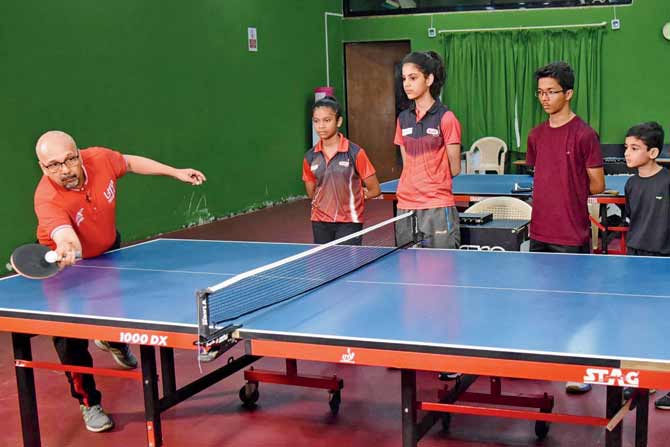
Kamlesh Mehta (left) demonstrates a shot to young table tennis players (right to left) Ananya Chande, Virendra Dandekar, Khush Waghani, Omkar Patil, Pearl Amalsadiwala and Shravani Loke look on during mid-day’s Masterclass at the Juhu-Vile Parle Gymkhana recently
It's good that a lot of NGOs and private players are coming in. Earlier, most of the grassroot level effort was left to the SGFI [School Games Federation of India] which used to conduct school games at the taluka level [sub-district]. However, not all federations have realised the importance of broad-basing the sport. For example, my company 11Sport, has prepared a grassroot level, pan-India inter-school program with 24 states participating. The government is also doing a lot at the grassroot level with the Khelo India initiative. However, there is always scope to do more. I would say the Indian government is probably the biggest supporter of sports today.
Is the government doing enough in terms of spending on foreign coaches or sending players abroad for training and competitions?
Let me start from the days when I received my first scholarship from SGFI. My first scholarship was worth Rs 600, which was pretty good at that time. It was then increased to R900. The entire camp expenses were taken care of by the government. Over a period of time, the government has done a lot and they have introduced the TOPS scheme for athletes capable of winning Olympic medals.
In India, academics is very important and as a result when a child reaches Class IX, most parents are in a dilemma about whether to let them study or allow them to continue pursuing sport. Sports is not a viable career at the moment. Most parents choose education and a lot of talented players stop pursuing sports thereafter. The government has also realised this and to reduce that, it is trying to make sport an alternative career. I am very happy with what the government is doing, but the government cannot do everything. Corporates and individuals also need to put in the effort to make sports a viable career.
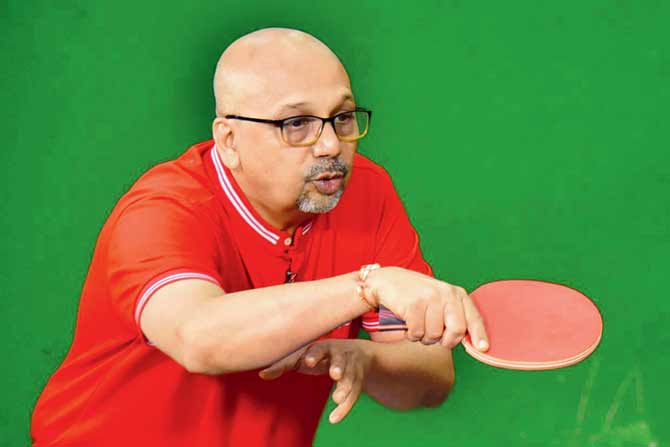
India is rising in world table tennis. What are we doing now that we were not doing in the past?
There was no TV coverage in my time. I hardly have any videos of my playing days. There was no information available of our heroes. There was no social media and internet. Social media has brought players and fans closer. There was hardly any international exposure in our times. We could not go for training abroad or play foreign tournaments. But today, parents are taking the time and effort to send their children to international tournaments from a very young age. The government and the table tennis federation have changed their rules and are allowing younger players to go abroad and participate in the junior circuit. Today, besides junior and senior circuits, we also have a 40-plus category. The exposure that most players get is huge nowadays.
Watch video of Masterclass With Ace Former National Champion Kamlesh Mehta
It's great that now a player can train abroad and learn about camps as that also helps him/her interact with foreign players.
Over the years, how have Indian players fared as far as competing with the world's best is concerned?
I would like to go back to our times where the German Bundesliga was considered the Mecca of table tennis. Every player would dream of playing there. However, our rules did not permit us to compete in it then. It is much easier to do so now. UTT [Ultimate Table Tennis league] has foreign and Indian players playing together in India. The idea was that our Indian players get to stay for 21 days along with foreign players. They train with them and are part of their regime, they discuss strategies and also get to play with them. This has helped develop so many of our players. Similarly, if you are playing in the Bundesliga for nine months, it will help you a lot. India's Chetan Baboor and Sharath Kamal play there regularly.
Now, even younger players including girls are going there. So, that's a very good change. This is also helping our Indian players better their game. We are still below the Chinese, but we are closing in. Now, we have two players in the Top 50 [Sathiyan and Kamal]. Manika Batra was in the Top 50 too. So, increased exposure due to participation in foreign leagues and having good interactions with foreign coaches besides individual foreign coaches, have all helped our players improve their standard.
Playing table tennis also has other advantages like improving hand-eye coordination and reflexes. Could you tell us about that?
There are various advantages of playing table tennis. To start with, the sport does not require too much infrastructure. Playing table tennis thoroughly improves hand-eye coordination. Control and speed are crucial. In table tennis, as you increase your speed, it helps with your reflexes too.
Shravani Loke: Could you explain the significance of a good serve?
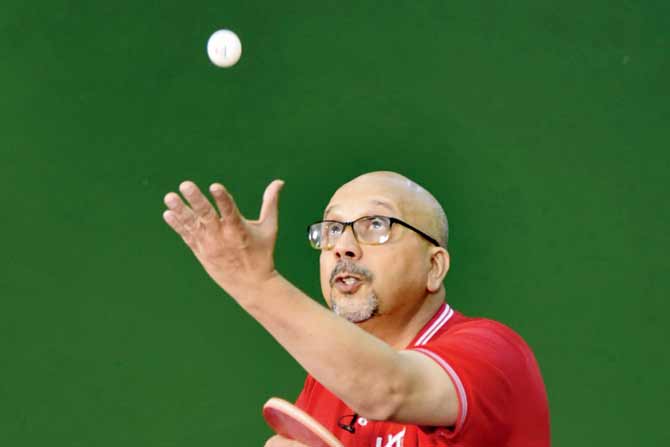 The Service
The Service
Kamlesh Mehta: For a good serve, your stance is very important. You should stand as close to the table as possible. The high toss, forehand service is the most common serve. If you are a right-hander, your left leg should be in front and right, behind. Your balance should be very good. The ball has to be placed in the centre of your palm and not on your fingers.
Bend your knees, watch the opponent from the corner of your eye and hold your racquet firmly to generate optimum spin. The elbow must be slightly away from the body. Toss the ball to a minimum of six inches and when it comes down, the point of contact is the most important factor. Toss the ball in such a way that it should be near your body. You should hit it as close to the table as you can, so that your opponent gets less time to react.
Pearl Amalsadiwala: Could you tell us about backhand attack and defence?
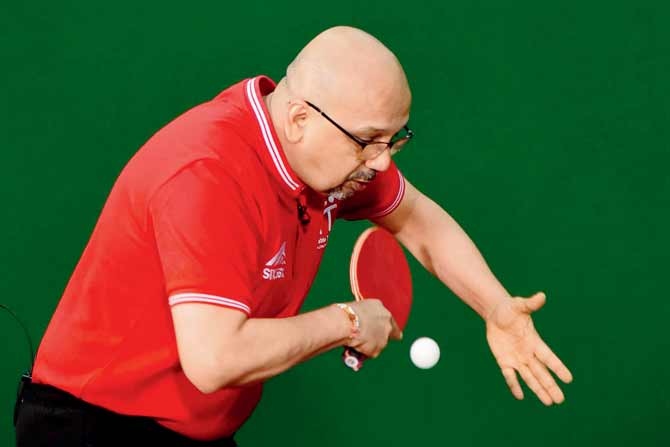 The Backhand
The Backhand
KM: During our time, we would play more with the forehand. Backhand was more of a stroke to continue the rally or a defensive stroke, where you push or block. All attacking strokes were played with the forehand. But the backhand is very important if you want to succeed. In the late 1970s, when the Hungarians developed the backhand top spin and backhand attack, the importance of the backhand increased significantly. Today, the game has become very fast.
Omkar Patil: Manika Batra uses a pimpled racquet. What are its advantages?
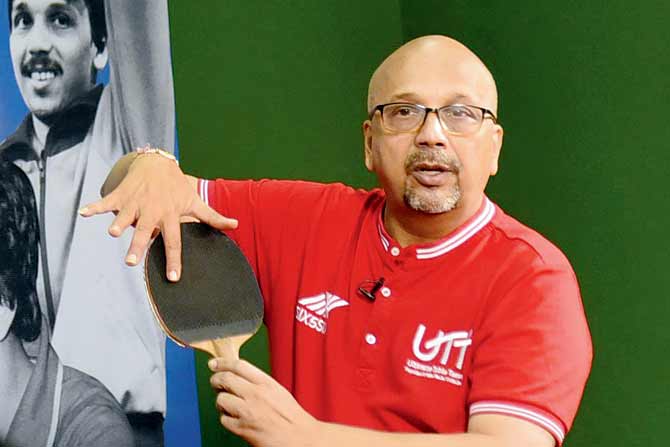 Pimpled Raquet
Pimpled Raquet
KM: Rubber plays a huge role. You should be very selective about your equipment. It is compulsory to have one side of the racquet red and the other black. There are two types of pimple rubbers — small and long. A pimpled racquet has advantages as well as disadvantages. One of the biggest advantages of the small pimple is that it helps you get better control but the disadvantage is that it generates very little spin.
The long pimple is also called the funny or magic rubber because the ball behaves in a funny manner. When a stroke is played, the action of the spin helps the opponent decide what kind of speed and direction he/she wants to give. But with the long pimple rubber, the spin generated is completely the opposite. Manika [Batra] uses a plain rubber on one side and a long pimple on the other. The advantage is that she plays very close to the table; it upsets the opponent as there is variation and the opponent needs to be sharper. The moment she plays the ball, the opponent goes on the defensive and she can attack. However, there is a disadvantage with the long pimple as there is only a certain kind of spin and speed you can generate, and whatever spin is generated by the opponent, there will be a fixed return with less variation. Most players the world over use a plain rubber.
Ananya Chande: Could you tell us how to defend against an attacking player?
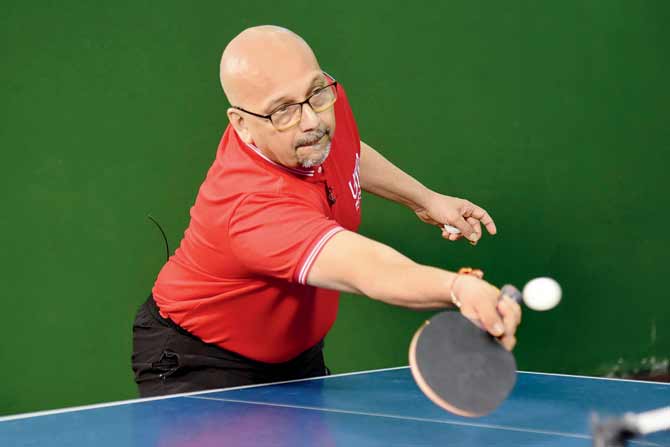 Receiving the ball
Receiving the ball
KM: Blocking is a defensive stroke played from close to the table to mute an attack. Attacking strokes are normally the top spin or a flat kill. The entire reply has changed from only blocking to counter-spinning. So, you have to use a counter forehand or backhand spin. To play counter-spin, your position is critical. If you are in a good position, you can play with good power. So, there are two things — one is the block and the other is counter-spin. These are the two options you have to counter any attack.
Receiving is as important as serving because 50 per cent of the game depends on receiving. An attentive stance with both arms above the table is very important while receiving. If your arm is below the table, it will consume more time [to get it up to the table]. Your eyes should be fixed on the opponent's point of contact because it will help you understand the kind of spin. To be a good receiver, one must understand the spin, which can be made out from the action and point of contact. A new trick/shot is the banana flick, where one can aggressively receive the ball and still generate spin on it.
Virendra Dandekar: How has top spin changed over the years?
KM: Top spin is the most important stroke if you aim to be a champion. It's an attacking stroke, which you can play from both the forehand and backhand. Top spin has gone through a lot of evolution. The action that we used to play with and the action used now has totally changed. When I was playing, our action began from the knee. But now, with the ball coming so fast, you don't need to have that long an action because you don't get that much time. The elbow position, which used to be down earlier, is now determined according to the height of the ball. For example, if the ball comes late, the elbow goes down and the action is shorter. The most important thing is connecting the ball. I have seen many players connecting the ball on the side of their body. Connecting the ball in front of your body is the ideal way to play top spin. It will give you good power and consistency. You cannot hit top spin without bending your knees and your body should be a bit tilted.
The backhand top spin is the opposite. Normally, to play backhand top spin, you rise up. But now, as the ball comes faster, there is a twist on the waist and a little power on the leg. When you turn, your wrist turns upwards and the hand-elbow movement is very quick. You have to connect on top of the ball.
There are three types of spin — forward, back and side. Side spin can be implemented with either top spin or back spin. However, forward and back spin cannot be done together. Understanding the spin is important because depending on it, your angle of the bat will be determined.
Khush Waghani: What are Team India's prospects at the 2020 Tokyo Olympics?
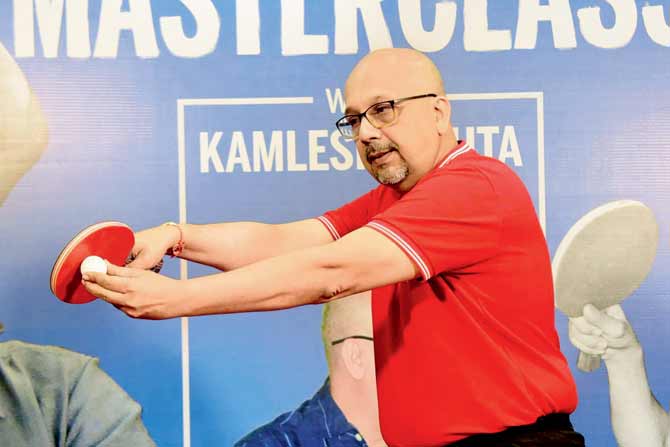
KM: At the Rio Olympics, we had four players who qualified. This time we are in a good position to qualify in the men's team event. We are still six to eight months away and players like Sharath Kamal, Sathiyan, Harmeet [Desai] and [Anthony] Amalraj are in the Top 120-130. Their performance in the coming tournaments will help us qualify for Tokyo. We will have a clearer picture by April 2020. Another event where we have a good chance is mixed doubles. Sharath and Manika won bronze at the Jakarta Asian Games. So, we are looking good for Tokyo 2020.
Also Read: Visually impaired girls train in table tennis in Pune
Catch up on all the latest sports news and updates here. Also download the new mid-day Android and iOS apps to get latest updates
 Subscribe today by clicking the link and stay updated with the latest news!" Click here!
Subscribe today by clicking the link and stay updated with the latest news!" Click here!






